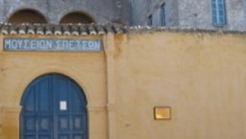

Greece
Aeges are located on the south side of the Macedonian fields. The name stands for “the place with many herds”. An omen that is said to have been given to Perdikkas
Aeges are located on the south side of the Macedonian fields. The name stands for “the place with many herds”. An omen that is said to have been given to Perdikkas A refers to their founding, connecting the name of the city to the herds of goats: (Diod. 17.16.1.1.) “where you will see snow white goats with shiny horns sleeping, on the grounds of this land, sacrifice to the almighty gods and build the center of a town”. The first Macedonian rural center is south of Aliakmonas, in the land that, according to Herodotos, was “the Macedonian land”, the cradle of Macedonians. The river acted as a natural fortification to the city from the dangers from the north, and at the same time ensured direct connection to the sea, which was then much closer, while at the location of the city, there was a junction of the main route, which, traversing the Pieria mountains, connected the Macedonian basin to south Greece, with the road that, starting from the ports of Pieria, and following the mountains, led to the north and to the east.
During a great construction programme that took place during the last years of the reign of Philip B, the new luxurious palace of Aeges is built, the theater next to it, and the neighbouring sanctuary of Euclea is modified with the royal offerings. Those buildings, for the construction of which the expensive poros, follow strictly the same architectural rules, even if this means serious construction issues, such as in the theatre. It is evident that behind these constructions lays a specific planning, inspired by a definite ideological position: the centre of the social and religious authority, that meet in the king’s existence, is combined with theatre, the center of art and civilization.
Continuing his ancestor’s, Archelaos, deeds, Philip B becomes the king, an «enlightened despot” according to platonic models, and begins in Aegae a tradition that will seal the image of the royal cities of the Hellenistic era, Pergamos, Antiocheia, Seleykeia, and will reach its climax in Alexandreia, with the construction of the legendary library and the museum, the first University the world ever had.
In the fields, north of the city, lays the vast necropolis of Aegae, the place where the Macedonian kings were buries. Centered around the cemetery of the tombs of the primal iron era (11th – 7th century BC), the necropolis expanded during the archaic years (6th – 5th century BC) to the south, to the west during the classical era (5th – 4th century BC) and to the east during the Hellenistic era (3rd – 1st century BC).
The epicenter of the archaeological digs, the necropolis has given many findings that prove, not only the belief in afterlife, but offer evidence to the Macedonian civilization itself, the borderer Greek race, that, staying out of the political and social developments in the south, kept up to the Hellenistic era structures, traditions and habits that reflect the world of the Homer’s epic.


The beach of Agia Roumeli with the white pebbles expands on the edge of the village which goes by the same name, on the exit of the Canyon of Samaria.-On the other hand, if you are looking for something more isolated, follow the E4 path east for 30 minutes up until you reach Agios Pavlos.


The archaeological collections was recently enriched with the generous offer of coins and numerous findings of various periods, that Adonis Kyrou had collected from all around the island, as well as from other places. A significant number of pictures and various ecclesiastical exhibits also comes from collection, and offers.


An especially unique island, blessed with beautiful beaches, and also with a history depicted through the ages.
1039 Ε 6061 01515 00